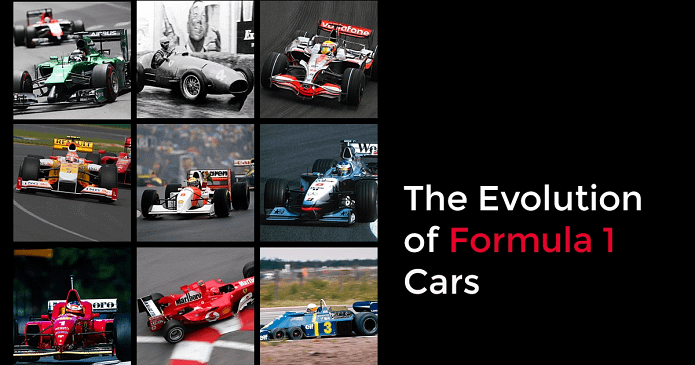Table of Contents
The Evolution of Formula 1 has only one constant – CHANGE. In the adrenaline-fueled world of Formula 1 this rings especially true when we look at the evolution of F1 cars, a journey that’s as thrilling as the races themselves. From their humble beginnings to the technological marvels they are today, Formula 1 cars have been at the forefront of automotive innovation, pushing the boundaries of speed, safety, and performance.
The Evolution of Formula 1
The Genesis of Speed: The Roar of the 1950s
Our journey begins in the 1950s, the era that gave birth to the Formula 1 World Championship. These early cars, while primitive by today’s standards, were revolutionary for their time. With front-engine designs and minimal safety features, they were raw, unforgiving machines. The Alfa Romeo 158, also known as the Alfetta, dominated this era. With its 1.5-liter 8-cylinder engine, it was a powerhouse on the track, laying the foundation for the speed obsession in Formula 1.




The 1960s and 1970s: Aerodynamics and Innovations
As we speed into the 1960s and 1970s, we witness a paradigm shift. The introduction of aerodynamic elements, like wings and spoilers, transformed cars into wind-cheating missiles. The Lotus 25, with its revolutionary monocoque chassis, set new standards for structural strength and lightness, proving that brains could triumph over brawn. The era also saw the introduction of slick tires, a game-changer that provided unprecedented grip and handling.




The Turbo Era: The 1980s Power Surge
The 1980s marked the dawn of the turbo era. Engines became smaller but ferociously more powerful. The turbocharged monsters of this era were both feared and revered. Cars like the McLaren MP4/4, powered by a Honda turbo engine, not only dominated the tracks but also captured the imaginations of fans worldwide. This was a time of excess and extravagance, where power often came at the cost of reliability.




The 1990s: Electronic Revolution and Safety Focus
As we enter the 1990s, the focus shifts from sheer power to technological sophistication and safety. The tragic losses of Ayrton Senna and Roland Ratzenberger in 1994 became a turning point, leading to major safety improvements. Cars became equipped with advanced electronics, traction control, and semi-automatic gearboxes, marking the beginning of Formula 1 cars as we know them today.




The 2000s: The Reign of Aerodynamics and Efficiency
The turn of the millennium saw Formula 1 cars evolve into highly efficient aerodynamic sculptures. This era was defined by greats like Michael Schumacher and teams like Ferrari and McLaren, who pushed the limits of aerodynamics. The cars became faster, safer, and more reliable, setting numerous records that still stand today.



The Hybrid Era: A Leap into the Future
The current era of Formula 1 is defined by the hybrid power units introduced in 2014. Combining traditional internal combustion engines with powerful energy recovery systems, these cars represent the pinnacle of automotive technology. They are not only faster but also more environmentally conscious, showcasing a commitment to innovation and sustainability.

The Road Ahead: Groundbreaking Changes for Closer Racing
Looking to the future, Formula 1 is set to undergo another transformation. With a focus on closer racing and sustainability, the new regulations aim to make cars more competitive and eco-friendly. The introduction of ground effect aerodynamics is poised to revolutionize car designs once again, ensuring that the spectacle of Formula 1 continues to evolve and excite.

Conclusion: A Legacy of Innovation
The evolution of Formula 1 cars is a testament to human ingenuity and the relentless pursuit of perfection. From the roaring engines of the 1950s to the hybrid powerhouses of today, each era has left an indelible mark on the sport and automotive technology. As Formula 1 continues to innovate, one thing is certain: the journey is just as exhilarating as the destination.

